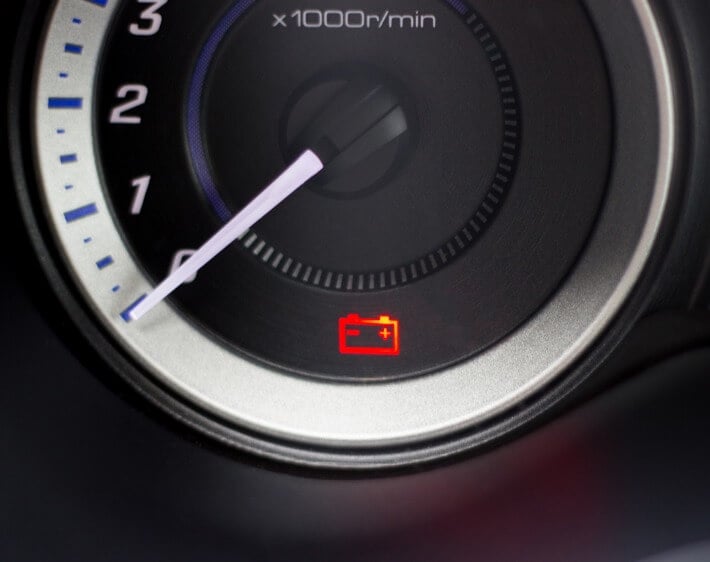When a car’s battery light is on but the car runs fine, it could indicate an alternator issue, loose battery connections, a faulty battery, or a damaged drive belt. All these issues can potentially cause the battery light to come on while the vehicle continues to operate without any apparent issues.
It’s crucial to address the root cause of the problem promptly to prevent any potential breakdowns or further damage to the vehicle. Ignoring the battery light could lead to a sudden breakdown or failure while driving, causing inconvenience and potentially costly repairs.
Understanding the possible causes and fixes for a battery light warning can help maintain the smooth operation of your vehicle and ensure safety on the road.

Credit: www.carfax.com
Cause 1: Low Battery Voltage
When your car’s battery light is on but the car runs fine, it could be due to low battery voltage. Low battery voltage can indicate a problem with your battery’s ability to hold and deliver a charge. Here are some possible causes and fixes for low battery voltage.
Corroded Battery Terminals
If your battery terminals are corroded, it can hinder the flow of electricity and result in low battery voltage. Corrosion can gradually build up over time due to exposure to moisture and other factors. To fix this issue:
- Disconnect the negative terminal (-) first and then the positive terminal (+).
- Use a wire brush or battery cleaning solution to remove the corrosion from the terminals.
- Rinse the terminals with water and dry them thoroughly.
- Apply a thin layer of petroleum jelly or a battery terminal protectant to help prevent future corrosion.
- Reconnect the positive terminal (+) first and then the negative terminal (-).
Faulty Alternator
If your alternator is faulty, it may not be charging the battery properly, leading to low battery voltage. Here’s what you can do:
- Start the engine and let it idle.
- Using a multimeter, check the voltage across the battery terminals.
- If the voltage reading is significantly below the recommended range, it indicates a faulty alternator.
- Take your car to a professional mechanic to have the alternator tested and replaced if necessary.
Parasitic Draw
A parasitic draw occurs when there is an abnormal flow of electricity in your car that drains the battery even when it’s not in use. To fix this issue:
- Inspect and repair any damaged or frayed wiring in your car.
- Check for any aftermarket installations that may be causing the parasitic draw.
- Consult a professional auto electrician to diagnose and resolve the issue.
Old Or Weak Battery
If your battery is old or weak, it may not be able to hold a sufficient charge, resulting in low battery voltage. To resolve this, you can:
- Have your battery tested to determine its capacity and health.
- If the battery is determined to be weak or old, replace it with a new one.
- Ensure that the new battery is compatible with your car’s specifications.
Cause 2: Malfunctioning Battery Sensor
Dirty Or Loose Battery Sensor Connections
Dirty or loose battery sensor connections can disrupt the accurate transmission of battery signals to the vehicle’s system, leading to a false battery warning light. Over time, corrosion or dirt buildup on the battery terminals can interfere with the sensor’s ability to detect the actual battery status. Additionally, loose connections can cause intermittent disruptions in the power supply, triggering the battery light while the car is running fine.
Faulty Battery Sensor
If the battery sensor itself is faulty, it may send erroneous signals to the vehicle’s computer system, causing the battery light to illuminate even when the battery is operating normally. A malfunctioning sensor can misread the battery’s voltage and trigger false alerts. In such cases, replacing the defective sensor is the most effective solution to rectify the issue and ensure accurate battery monitoring.
Cause 3: Faulty Wiring Or Connections
Begin HTML responseYour car’s battery light being on despite the vehicle running smoothly could indicate a ‘Cause 3: Faulty Wiring or Connections.’ This issue may arise due to several factors like loose cables, faulty ground connections, or damaged wiring.
Loose Or Damaged Battery Cables
- Inspect the battery cables for any signs of wear or corrosion.
- Ensure the cables are securely connected to the terminals.
- Loose or damaged cables can disrupt the flow of electricity.
Faulty Ground Connections
- Check the ground connections for rust or looseness.
- Faulty ground connections can lead to erratic electrical signals.
- Securely tighten the connections to ensure a stable grounding.
Faulty Wiring
- Inspect for any frayed or damaged wires in the car’s electrical system.
- Faulty wiring can cause erratic electrical behavior.
- If any damaged wiring is found, replace it promptly to avoid further issues.

Credit: www.wikihow.com
Cause 4: Problem With The Charging System
If your battery light is on but your car runs fine, it could indicate an issue with the charging system. This crucial system ensures your battery stays charged, allowing your vehicle to power essential components.
Faulty Voltage Regulator
A faulty voltage regulator can disrupt the charging process, leading to the battery light staying on. It’s responsible for regulating the amount of voltage sent to the battery, so any malfunction can cause issues.
Defective Diode
A defective diode can also impact the charging system, preventing the battery from receiving the correct charge. Diodes are essential in converting AC current from the alternator into DC current for the battery.
Broken Drive Belt
A broken drive belt can hinder the alternator’s ability to charge the battery. The drive belt connects the engine’s crankshaft to the alternator, and if it breaks, the alternator can’t function properly.
Fix 1: Check Battery Terminals
When the battery light on your car’s dashboard is illuminated but the car seems to be running fine, it can be perplexing. Nonetheless, one of the possible reasons for this could be an issue with the battery terminals.
Cleaning Corroded Terminals
Corroded terminals can hinder the flow of electricity from the battery to the various components of the vehicle. It’s important to clean these terminals regularly to ensure a strong connection and maximum power transfer.
- First, disconnect the negative terminal of the battery.
- Then, use a mixture of baking soda and water to clean away the corrosion.
- After cleaning, apply a small amount of petroleum jelly to the terminals to prevent future corrosion.
Tightening Loose Terminals
Loose terminals can cause intermittent connections, leading to the battery light coming on. It’s crucial to check the terminals regularly and ensure they are tightly secured.
- Start by checking the tightness of the terminal bolts with a wrench.
- If they are loose, use the wrench to securely tighten them, being careful not to over-tighten.
- Inspect the terminals regularly to ensure they remain secure.
Fix 2: Test And Replace Alternator
If you notice that your battery light comes on, but your car is running fine, it could be due to a faulty alternator. The alternator is a crucial component of your vehicle’s charging system, responsible for keeping the battery charged while you drive. In this section, we will explore how to test and replace a faulty alternator.
Testing Alternator Output
Before replacing the alternator, it is essential to determine whether it is indeed the cause of the battery light coming on. To test the alternator’s output, follow these simple steps:
- Start your car and let it idle.
- Using a multimeter, set it to the DC voltage range.
- Connect the multimeter’s positive lead to the positive terminal of the battery and the negative lead to the alternator’s B+ or output terminal.
- Read the voltage displayed on the multimeter.
- A properly functioning alternator should produce a voltage between 13.8 and 14.8 volts. Anything below or above this range may indicate a faulty alternator.
Remember to exercise caution and refer to your vehicle’s manual for specific instructions on conducting this test, as it may vary depending on the make and model of your car.
Replacing Faulty Alternator
If your alternator fails the output test or shows signs of being faulty, the next step is to replace it. Here is a step-by-step guide on how to replace your alternator:
- Disconnect the negative terminal of the battery to prevent any electrical mishaps.
- Locate the alternator in your engine bay; it is usually connected to the engine with bolts and held in place by a mounting bracket.
- Loosen the bolts securing the alternator and remove any electrical connections attached to it.
- Carefully remove the faulty alternator from the engine bay and set it aside.
- Install the new alternator in the reverse order, making sure to reconnect all electrical connections securely.
- Tighten the bolts to secure the alternator in place.
- Reconnect the negative terminal of the battery.
After replacing the alternator, start your car and check if the battery light remains off. If it does, your problem has been resolved. However, if the light continues to come on, it is recommended to consult a professional mechanic for further diagnosis.
Fix 3: Identify And Fix Parasitic Draw
To address the battery light issue when the car runs smoothly, you can investigate and resolve parasitic draw. This method entails pinpointing and rectifying any power drain sources in the vehicle’s electrical system to alleviate the warning light concern.
Detecting Parasitic Draw
What is Parasitic Draw?
Parasitic draw refers to the situation where your car battery continues to drain even when the vehicle is turned off. This can be caused by various electrical components that are drawing power from the battery when they shouldn’t be. While a small amount of draw is common in modern vehicles, excessive draw can lead to a dead battery and trouble starting your car.
How to Detect Parasitic Draw?
Detecting parasitic draw requires some diagnostic work, but it can be done with a multimeter and a few simple steps. Here’s how you can identify if your car has a parasitic draw:
- Ensure your vehicle is parked in a safe and well-lit area.
- Turn off all the electrical components such as lights, music, and air conditioning.
- Disconnect the negative battery cable from the battery terminal.
- Set your multimeter to measure DC amps and connect it in series between the battery and the disconnected cable.
- Check the reading on the multimeter. Ideally, it should be around 50 milliamps or less. Anything higher indicates a potential parasitic draw.
If you’re not comfortable performing these steps yourself, it’s best to consult a professional mechanic who can help diagnose and resolve the issue.
Resolving Parasitic Draw Issues
Identifying the Culprit
Once you’ve determined that your car has a parasitic draw, the next step is to identify the specific component or system causing the issue. Here are some common culprits:
| Common Culprits of Parasitic Draw | Potential Fixes |
|---|---|
| Interior lights and glove box lights | Check for faulty switches or wiring, replace as needed. |
| Faulty aftermarket accessories (alarms, stereo systems) | Consult a professional to troubleshoot and repair or replace the faulty accessory. |
| Malfunctioning control modules | Have the control modules diagnosed and repaired by a qualified technician. |
| Short circuits or damaged wiring | Inspect the wiring for any signs of damage and repair or replace as necessary. |
Fixing the Issue
Once the culprit has been identified, you can take steps to fix the parasitic draw. Depending on the specific issue, the following fixes may be required:
- Replacing faulty switches, wiring, or control modules.
- Disconnecting or repairing aftermarket accessories.
- Repairing or replacing damaged wiring or fixing short circuits.
- Updating or reprogramming the vehicle’s software if necessary.
It’s important to note that resolving parasitic draw issues can be complex, and it may be best to seek professional assistance if you’re unsure or inexperienced in dealing with electrical systems.
Fix 4: Replace Old Or Weak Battery
If your battery light is on but your car runs fine, it may be time to consider replacing your old or weak battery. A faulty battery can cause the warning light to illuminate, even if the car is operating normally. In this section, we will discuss how to test battery health and the process for replacing the battery.
Testing Battery Health
To determine if your battery is the source of the issue, you can perform a simple test to check its health. Start by using a voltmeter to measure the voltage of the battery. A healthy battery should have a voltage reading of around 12.6 volts when the car is turned off. If the reading is significantly lower, it may indicate that the battery is weak and in need of replacement.
Replacing Battery
If the battery test reveals that it is old or weak, it’s time to replace it. Before starting the replacement process, ensure the car is turned off and the negative terminal is disconnected to prevent any electrical hazards. Then, carefully remove the old battery and install the new one, ensuring the terminals are securely connected. Finally, reconnect the negative terminal and start the car to confirm that the battery light is no longer illuminated.

Credit: www.firestonecompleteautocare.com
Conclusion
To wrap up, a battery light coming on can indicate various underlying issues within your vehicle’s electrical system. It’s crucial to address the problem promptly to prevent potential breakdowns. By understanding the possible causes and implementing the appropriate fixes, you can ensure the smooth running of your car and maintain its performance and safety.


